
75 mm Gun M1917
Encyclopedia
The 75 mm Gun Model of 1917 (British) was an interim measure, based on the British QF 18 pounder
, produced by the United States in World War I
after it had decided to switch from 3 inches (76.2 mm) to 75 mm calibre for its field guns.
to switch from 3 inches (76.2 mm) to 75 mm calibre for its field guns. Its preferred gun for re-equipment was the French 75 mm Model of 1897
, but early attempts to produce it in the US using US commercial mass-production techniques failed, partly due to delays in obtaining necessary French plans, and then their being incomplete or inaccurate, and partly because US industry was not equipped to work to Metric measurements. By 1917 US firms had produced 851 QF 18 pounders for export to Britain. Hence production of a 75 mm version offered a simple interim solution, being basically a copy of the British QF 18 pounder rechambered for French 75 mm ammunition, utilizing existing production capacity. It remains very similar to the 18 pounder, the main visible difference being a shorter barrel with straight muzzle.
The gun was developed too late to see action in World War I
.
against the USSR in 1940. They arrived too late to be used in that war but were designated "75 K/17 " and after necessary overhaul were used in the Continuation War from 1941, and many continued in use for training until the 1990s..
Britain lost many of its field guns in France, and the US transferred its large remaining stocks of the Model of 1917 to Britain where its similarity to the 18 pounder made it useful for British home defence and training needs.

Ordnance QF 18 pounder
The Ordnance QF 18 pounder, or simply 18-pounder Gun, was the standard British Army field gun of the World War I era. It formed the backbone of the Royal Field Artillery during the war, and was produced in large numbers. It was also used by British and Commonwealth Forces in all the main theatres,...
, produced by the United States in World War I
World War I
World War I , which was predominantly called the World War or the Great War from its occurrence until 1939, and the First World War or World War I thereafter, was a major war centred in Europe that began on 28 July 1914 and lasted until 11 November 1918...
after it had decided to switch from 3 inches (76.2 mm) to 75 mm calibre for its field guns.
History
The US decided early in World War IWorld War I
World War I , which was predominantly called the World War or the Great War from its occurrence until 1939, and the First World War or World War I thereafter, was a major war centred in Europe that began on 28 July 1914 and lasted until 11 November 1918...
to switch from 3 inches (76.2 mm) to 75 mm calibre for its field guns. Its preferred gun for re-equipment was the French 75 mm Model of 1897
Canon de 75 modèle 1897
The French 75mm field gun was a quick-firing field artillery piece adopted in March 1898. Its official French designation was: Matériel de 75mm Mle 1897. It was commonly known as the French 75, simply the 75 and Soixante-Quinze .The French 75 is widely regarded as the first modern artillery piece...
, but early attempts to produce it in the US using US commercial mass-production techniques failed, partly due to delays in obtaining necessary French plans, and then their being incomplete or inaccurate, and partly because US industry was not equipped to work to Metric measurements. By 1917 US firms had produced 851 QF 18 pounders for export to Britain. Hence production of a 75 mm version offered a simple interim solution, being basically a copy of the British QF 18 pounder rechambered for French 75 mm ammunition, utilizing existing production capacity. It remains very similar to the 18 pounder, the main visible difference being a shorter barrel with straight muzzle.
The gun was developed too late to see action in World War I
World War I
World War I , which was predominantly called the World War or the Great War from its occurrence until 1939, and the First World War or World War I thereafter, was a major war centred in Europe that began on 28 July 1914 and lasted until 11 November 1918...
.
Finnish service
Finland purchased 200 old guns from the United States for its Winter WarWinter War
The Winter War was a military conflict between the Soviet Union and Finland. It began with a Soviet offensive on 30 November 1939 – three months after the start of World War II and the Soviet invasion of Poland – and ended on 13 March 1940 with the Moscow Peace Treaty...
against the USSR in 1940. They arrived too late to be used in that war but were designated "75 K/17 " and after necessary overhaul were used in the Continuation War from 1941, and many continued in use for training until the 1990s..
British service
Early in World War IIWorld War II
World War II, or the Second World War , was a global conflict lasting from 1939 to 1945, involving most of the world's nations—including all of the great powers—eventually forming two opposing military alliances: the Allies and the Axis...
Britain lost many of its field guns in France, and the US transferred its large remaining stocks of the Model of 1917 to Britain where its similarity to the 18 pounder made it useful for British home defence and training needs.
Greek service
The gun entered in Greek service during the Greco-Italian war of 1940-1941. Greece requested aid from Britain and USA, which in part came in the form of the British 75mm field gun. A total of 50 by Britain in January and 24 by the US in March 1941 were offered. Of those, 24 were sent from Britain, but only 18 arrived in January 1941 to Greece. The rest of the offered guns were either sunk or never loaded on ships due to the fall of Greece in April 1941. The 18 that arrived to Greece were in need of maintenance before being pressed into service. Ultimately 4 guns saw service with the 19th Field Artillery Battalion, and 12 guns with the B3 Field Artillery Battalion.Surviving examples

- "Minnie" is displayed at the United States Army Ordnance Museum, MD
- Imperial War Museum, Duxford, England
- The Central Museum of The Royal Regiment of Canadian Artillery, CFB Shilo, Manitoba, Canada

